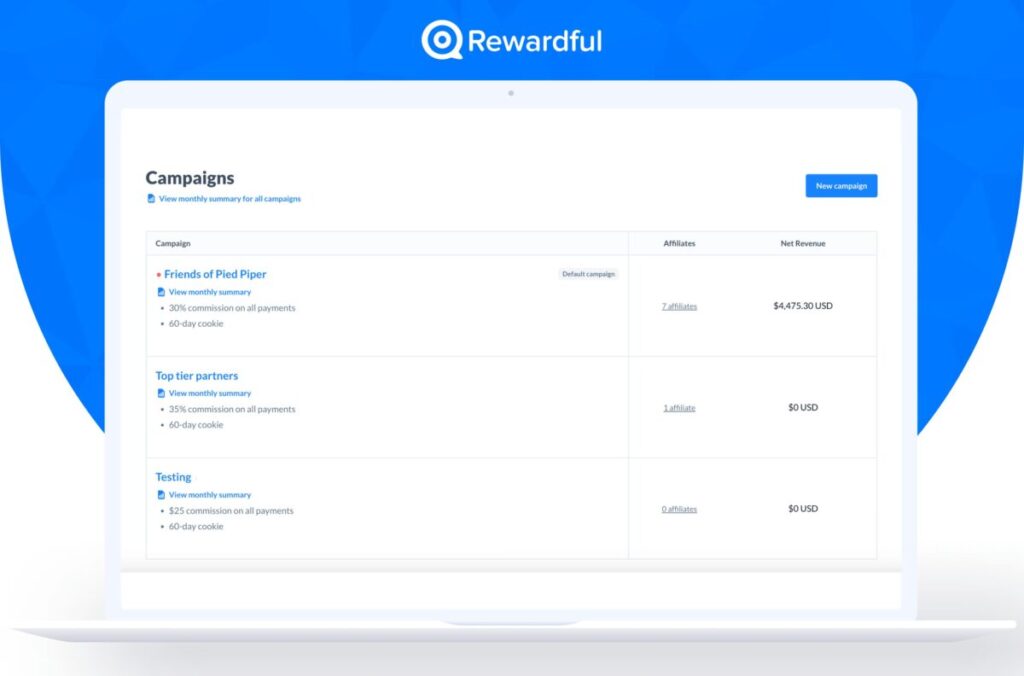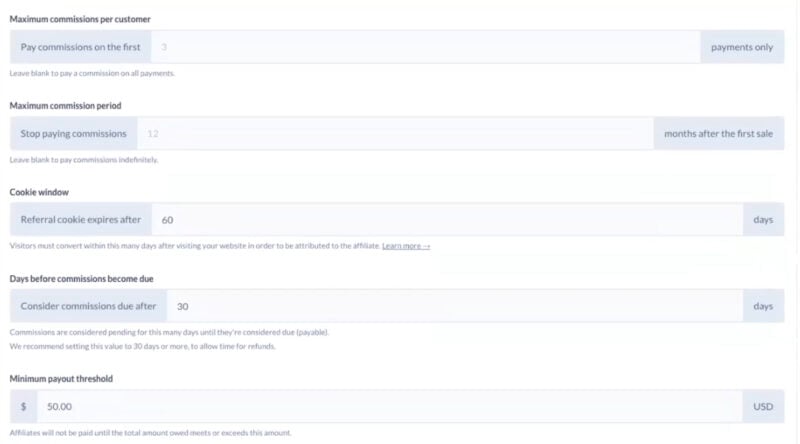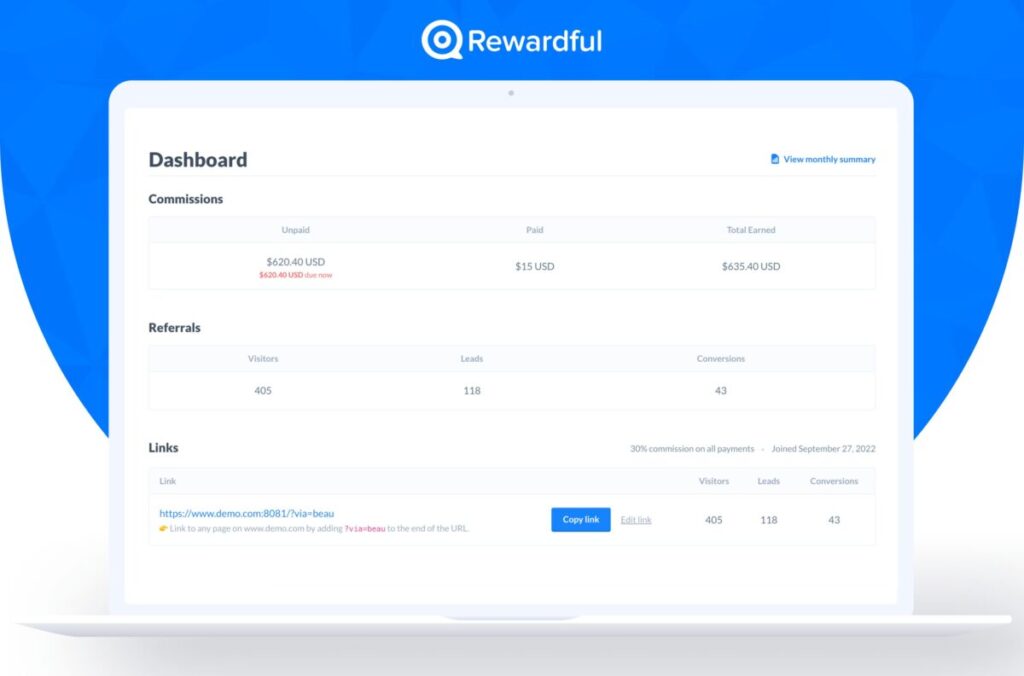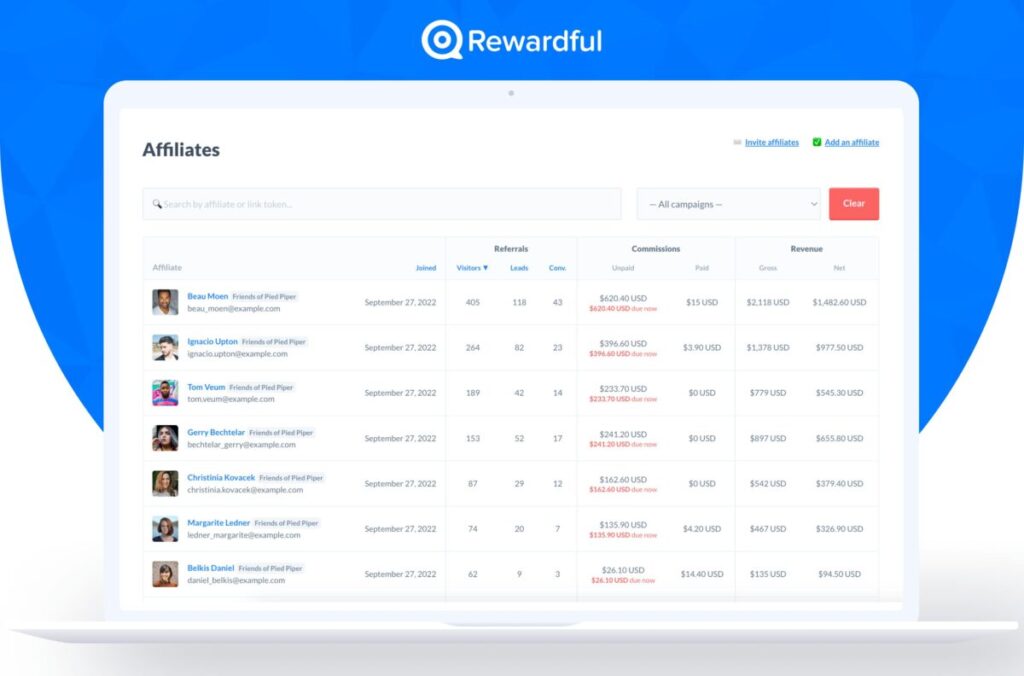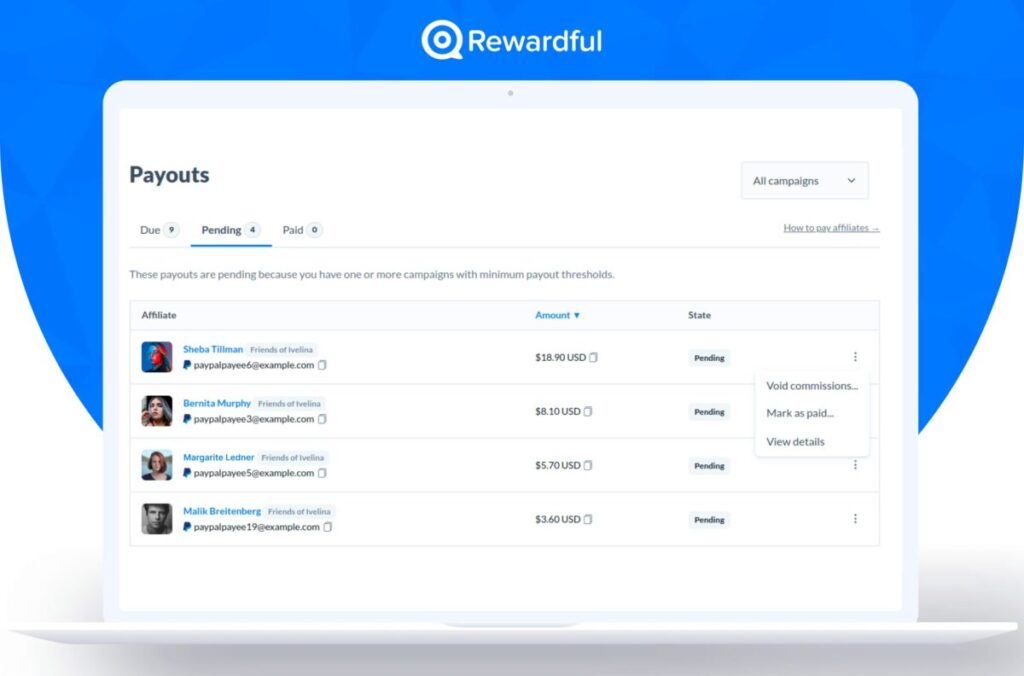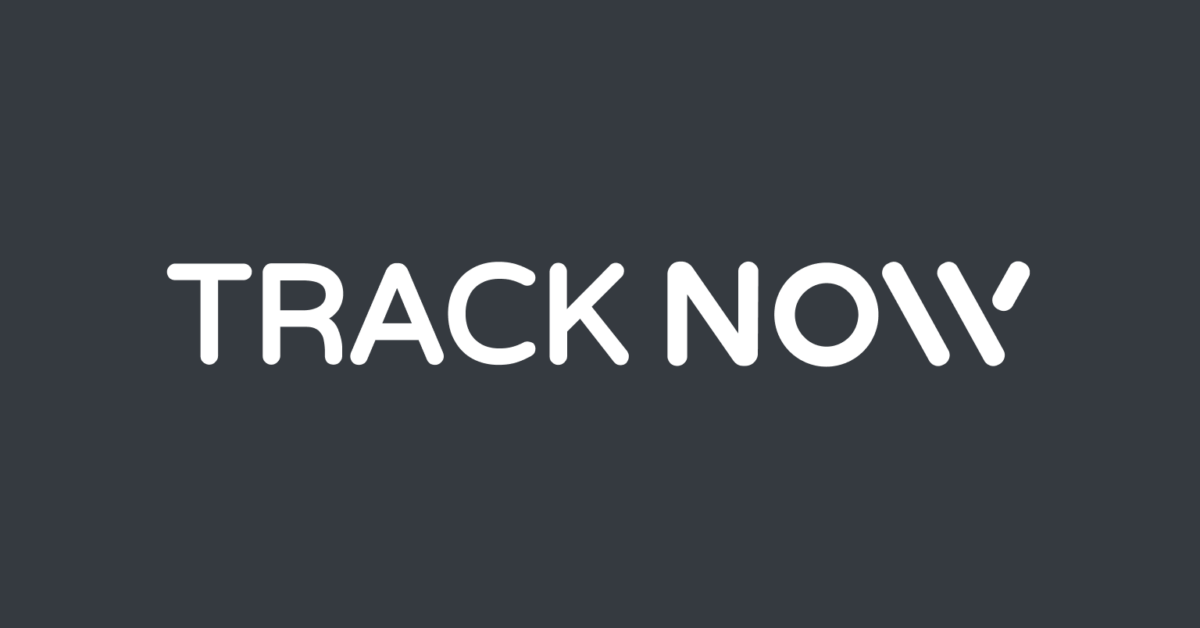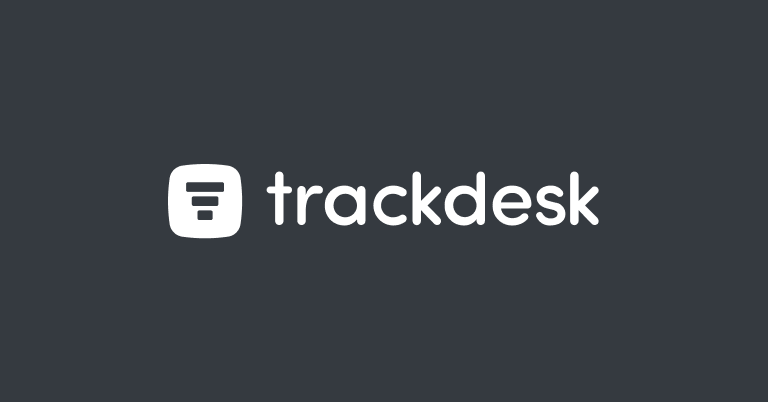
Overview
Initially founded by Kyle Fox and Brady Cassidy in Canada, Rewardful is now a brand that belongs to saas.group, and it is led by Emmet Gibney, CEO of the company.
Back in 2017, Kyle and Brady experienced a common challenge: existing affiliate software was either overpriced or too complex. Together, they had a mission: building an easy-to-use and affordable affiliate marketing software for businesses of all sizes. Rewardful was born: an accessible and user-friendly tool to manage affiliate marketing programs.
Today, Rewardful is used by thousands of customers worldwide and from all industries (SaaS, Tech, eCommerce, etc), providing them with the features they need to boost their MRR and grow their brand awareness through affiliate marketing.
Rewardful is tailored specifically toward SaaS companies—and other subscription-based services—to use. This isn’t to say that it’s only good for brands who live off of monthly revenue; Rewardful works just as well for regular old one-time purchases. But if your company’s model is subscription-based, you know your business model is a little more complex to incentivize—recurring charges bring more variables into the equation.
Users of Rewardful have found they have much more control and flexibility to create functional affiliate programs that work on their terms.
Pricing
SaaS is as SaaS does, and so Rewardful has a few different levels of service offered as a monthly subscription. All plans come with a 14-day free trial, giving you the freedom to test out the service before making a commitment.
- Starter, $49/mo —This plan is designed for those who are just beginning their affiliate marketing journey. For a zero percent transaction fee and a maximum of $7,500 affiliate revenue per month, you can enjoy benefits such as unlimited affiliates and visitors, access to all integrations, the REST API, and bulk payouts via PayPal and Wise.
- Growth, $99/mo —Building upon the Starter plan, the Growth option extends your affiliate revenue limit up to $15,000 a month with a zero percent transaction fee. This plan is their most popular choice and is ideal for businesses looking to expand their reach.
- Enterprise, $149+/month —The Enterprise plan is for the most ambitious of businesses. With a zero percent transaction fee, it allows for unlimited affiliate revenue, making it the ultimate option for those who want no bounds on their growth. It includes all the features of the Growth plan and adds phone support to the mix for comprehensive customer service.
Each Rewardful plan includes a quick 5-step setup using either our pre-built integrations or by copying two scripts. It offers flexible, SEO-friendly links with easy direct page tracking and deep integration with Stripe for an efficient two-way data sync.
The Details
We went into the demo of this software with the idea of “making products that work well and look good” rattling around in our collective heads. At first glance, you can see that it looks good—not beautiful or dazzling, just good, and that’s perfect. It’s business software, you don’t need to fall in love with it. But it works so well you just might, anyway.
The simplicity of its form allows the function to shine, and this becomes immediately apparent as you create your first affiliate campaign within Rewardful. It’s pretty straightforward—and continues to be even after you get to the part where you define the terms of your affiliates’ rewards. For a one-time purchase, you choose a percentage of the total sale or a flat-rate payout and you’re done with it. For a subscription service, however, you can click on Rewardful’s Advanced Options to set more parameters.
A monthly subscription is only lucrative over the long haul—you don’t want to payout a big reward only for the new sale to cancel quickly. And an affiliate isn’t going to see much incentive in a percentage of just the first month. With Rewardful’s advanced options, you have finer control: a percentage or flat rate that’s paid on a recurring basis, but you can define how long that is—for the first 3 months, the first 6 months, whatever you want. Commissions can also be adjusted up or down based on the level of subscription a new customer chooses—this is auto-adjusted through the lifecycle of a customer, too. Another setting that recurring revenue seekers will appreciate is the minimum payment threshold. It costs money to move money, so you don’t want to payout every time a commission is generated.
Beyond these recurring payment settings are a host of other small, but important, ones. There’s a grace period before a commission is actually considered payable which, for obvious reasons, should be at least as long as your refund window. By default, affiliates don’t see the customer names associated with their referrals, but you can use Rewardful to pay commissions to your business partners, too. In the case of a reseller, you’d turn on this feature—your customers are theirs, and they’ll want to know who they are.
Having created your campaign, you’ll have a landing page where your affiliates can sign up. There’s also an option to invite affiliates (and you can make your campaign private/invite-only). From there, Rewardful handles all the heavy lifting of actually running your affiliate program. It almost feels like you haven’t done enough, like it was too easy. But as your campaign goes on, the analytics are there to show you all the sales you’ve made without having done much to get them—which is pretty much the point of affiliate marketing.
The sales data is presented in a way that helps you to understand your entire funnel, not just sales. People who’ve clicked through a referral to your site are measured as a distinct group, and then the groups are further segmented: a person who’s signed on to a free trial is categorized as a lead. If they end up signing on, that’s a conversion. Total sales are differentiated from that. In this way, Rewardful is like its own little sales division, operating without much oversight and reporting back automatically.
Of course, it really is a sales division, and your affiliates are the sales staff. Though they don’t work for you, you’ll of course want visibility into their performance. Rewardful does a good job here of letting you dig deep into the weeds of your affiliates' performance, showing you the number of visitors they drove to your site and their leads, conversions, total sales and commissions. It also does the math for you on the net revenue, for good measure. You can scroll through every sale they made, along with what they sold and to whom they sold it.
Another highlight of Rewardful is its ability to do mass payouts. It’s a tough balancing act to make it easy while limiting the fees; once you’re on the Starter plan, Rewardful doesn’t take any fees at all. And that’s good, because PayPal and Wise—the two supported bulk payment services—most definitely will. Rewardful’s role in effecting the payouts is to generate a compatible CSV file that you upload to one of those payment services, which will then direct the payments. Then it’s just a matter of marking everything as “paid” in Rewardful. It isn’t the most modern-feeling solution, but it also isn’t very difficult or time consuming. It makes perfect sense for Rewardful’s target market.
Integrations
As far as sales tracking is concerned, Rewardful integrates with both Stripe and Paddle, both of which are the go-to for businesses with recurring revenue models. It would be great to see them integrate with additional platforms to accommodate a wider range of businesses. The software works just as well for companies offering information products, online courses, and online communities, and expanding their integrations could further broaden their potential customer base.
Rewardful also integrates with several email marketing platforms, one of which you’re probably using (or will want to use) to communicate en masse with your affiliates. When you integrate with one of the supported platforms—Customer.io, Active Campaign, ConvertKit, Drip, Mailchimp, MailerLite, and Userlist—new affiliates are automatically added as recipients.
Conclusion
It’s a cliche at this point to mention how much more it costs to acquire a new customer than it is to keep an existing one. But we’ll mention it, anyway: about five times more. Affiliate marketing programs are one of the most effective—and low cost—ways to acquire new customers, and you do it while keeping your current ones happy.
Rewardful takes full advantage of this dynamic and adds very little in the way of cost or complexity to do it. They cater to a significant portion of the market, primarily focusing on small businesses such as SaaS companies, as well as those offering information products, online courses, and online communities. This makes Rewardful a no-brainer for brands in these categories, providing an effective solution tailored to their unique needs. Not laden with any extraneous bells or whistles, Rewardful is the fruit of its co-founder’s passion. It works well and looks good. How much more could you ask?
Rating
-
Features
-
Ease of Use
-
Reporting

